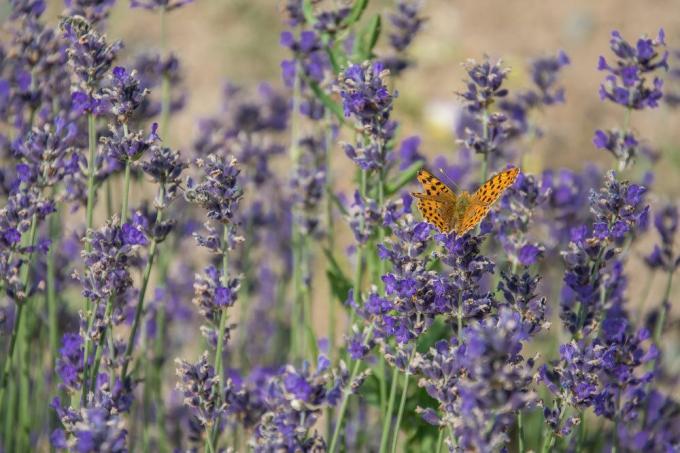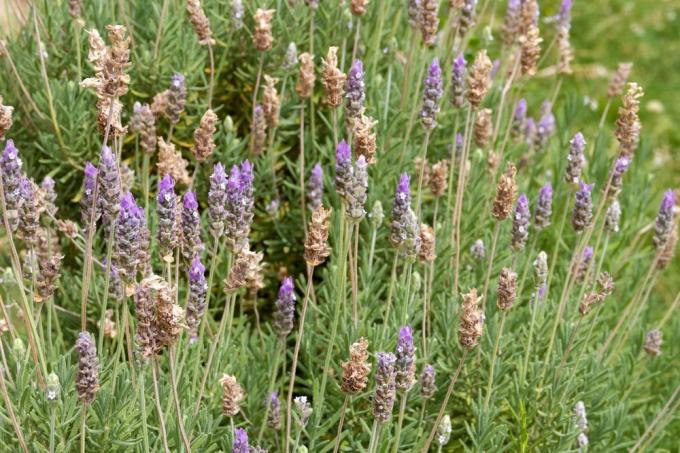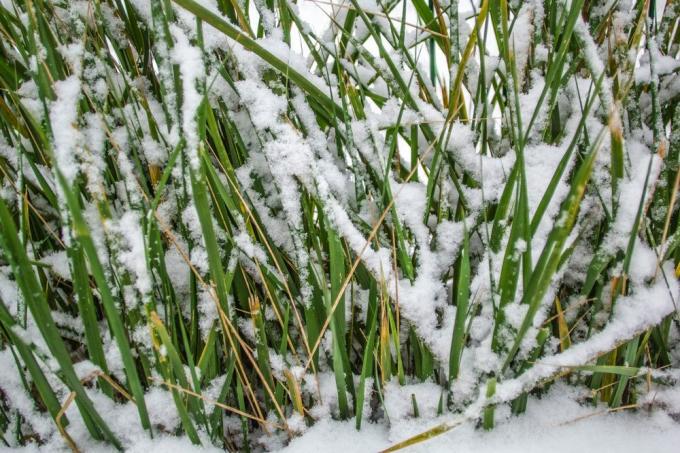
table of contents
- Lavender species
- Hardiness
- Cold zones
- Protection against frost
- Protection against the sun
- Hardy lavender varieties in a pot
- Species sensitive to frost
- Protection from frost
- Failure to overwinter
Lavender is one of the most popular garden plants in our home beds and borders. The fragrant subshrub originally comes from the coastal regions of the Mediterranean. There it is used to dry, warm climates and is therefore considered to be particularly easy to care for. But can you easily overwinter the Mediterranean plant with us? Which types of lavender are suitable for year-round outdoor cultivation and what should you watch out for when overwintering?
Lavender species
There are around 30 different types of lavender. But not every type of lavender is hardy and can survive the winter unprotected in our latitudes. While the real lavender (Lavandula angustifolia) is considered hardy, other species are somewhat sensitive to frost. These must either be very well protected in winter or ideally placed in a cold house immediately in order to survive the cool temperatures undamaged.
Real lavender, English lavender (Lavandula angustifolia)
- hardy
- frost-resistant down to -15 degrees
Speiklavender, Great Speik (Lavandula latifolia)
- conditionally hardy
French lavender, Spanish or Arabic lavender (Lavandula stoechas)
- not hardy
Provence lavender (Lavandula intermedia)
- conditionally hardy
Fern-leaved lavender, oregano lavender (Lavandula multifidi)
- frost-resistant only up to -5 degrees

Hardiness
When buying a lavender, pay close attention to the names given with regard to frost hardiness or winter hardiness. It is easy to confuse the terms “winter-proof” and “hardy”. These two terms by no means mean the same thing. All plants that survive temperatures below freezing for a short period of time are referred to as winterproof. During longer periods of frost or severe frosts, these plants freeze to death even if they are in a protected location.
Frost-hardy or winter-hardy varieties, on the other hand, are largely insensitive to fluctuating temperatures and permanent frosts. However, the term hardy is no guarantee that the lavender will survive the winter unscathed. It is also important to know that hardiness and hardiness are not the same thing. While frost-hardy plants can survive long periods of low temperatures, they are sensitive to strong temperature fluctuations.
Cold zones
Germany alone is divided into seven different cold zones. And not every winter is the same. The minimum temperatures and the duration of the frost periods can differ quite a bit. While almost all types of lavender, with the exception of the potted lavender, in a wine-growing region without prejudice in the open air can be left, they will hardly be in coastal or mountain regions, the strongly changing temperatures and permanent frosts survive.

Hibernate bedding plants
Basically only plant hardy varieties such as real lavender in the garden soil. If a few simple rules are followed, hardy lavender species can easily overwinter outdoors. The following varieties of Lavandula angustifolia have proven themselves well for outdoor planting.
- Hidcote Blue
- Munstead
- Imperial Gem
- Miss Katherine
Protection against frost
Even hardy varieties of lavender are not indefinitely resistant to icy temperatures. The subshrub is not particularly fond of permanent frost. From -15 degrees, the plant needs additional protection.
- only in warm winter regions without protection (wine-growing regions)
- sheltered from the wind
- Cover the root area with straw, mulch or brushwood
- Time: beginning of October
- prune back in September
- protect against waterlogging
- watering: only on frost-free, dry days
- Cover below -15 degrees with a straw mat or fleece
Protection against the sun
But lavender doesn't just need to be protected from frost. Rather, it is the combination of sunshine and frost that troubles the Mediterranean flowering shrub. In summer, lavender prefers a location that is as sunny as possible. However, this can be his undoing in winter. When the sun is shining, the water in the leaves evaporates faster. However, when it is frosty, the plant cannot quickly absorb new water through the roots. This means that there is a risk that the lavender will dry up - even in winter.

- places in full sun: cover the plant with brushwood
- unprotected, sunny locations: cover with fleece
- alternatively, attach a sunscreen next to the plant
In windy locations, the lavender may need additional protection. If there is snow on the plants, do not remove it, because the snow cover also protects against the sun and cold temperatures.
Hardy lavender varieties in a pot
If Lavandula angustifolia is cultivated in a tub, it can be left outside in winter. However, the Mediterranean plant needs a sheltered, preferably dry and not too sunny location for the cold season. Ideally, the bucket is simply moved around. A protected house wall is ideal for this. It stores heat during the day and releases it again at night. In addition, the place offers protection from icy winds.
- Place the bucket on an insulating mat, styrofoam or wooden blocks
- Terracotta pots are particularly suitable
- bind excess moisture (protects the roots from frostbite)
- If it is very cold, insulate the pot with straw mats
Species sensitive to frost
Those who choose lavender varieties that are sensitive to frosts should do so best Plant them in a tub right away, with which the plants can then easily move to their winter quarters can.

Types that are sensitive to cold include:
- Coppy lavender
- Speiklavender
- Lavandin (Provence Lavender)
Protection from frost
Bringing the lavender to a warm apartment during the first frosts is the wrong decision. Depending on the season, it is too dark and too warm for the plants. The fragrant plants are better off in a cool, but frost-free place.
- dry
- Frost free
- cool
- Temperatures between 5 and 10 degrees are ideal
- basement, cellar
- garage
- Glasshouse
- unheated winter garden

Failure to overwinter
One of the most common mistakes made when wintering lavender is choosing the wrong type of lavender. Since not all varieties are sufficiently frost-resistant, a large number of plants do not survive the winter. In addition, there is too much pouring. Make sure that buckets and pots have adequate drainage facilities. Watering is only allowed when the ground is not frozen and the water can seep into the ground.
- wrong type of lavender
- Waterlogging
- too windy location
- lack of insulation in potted plants
- Winter in heated rooms
- strong temperature fluctuations
